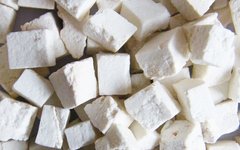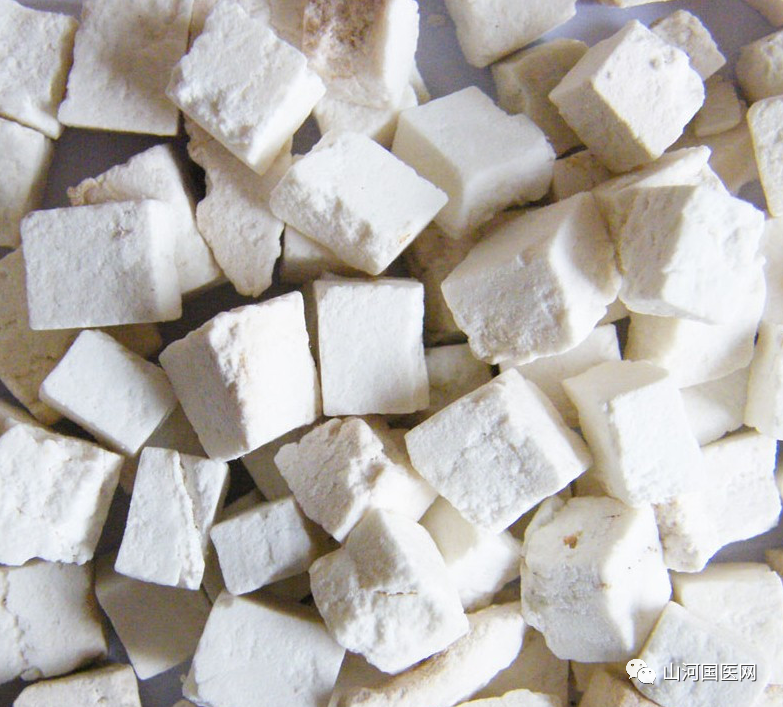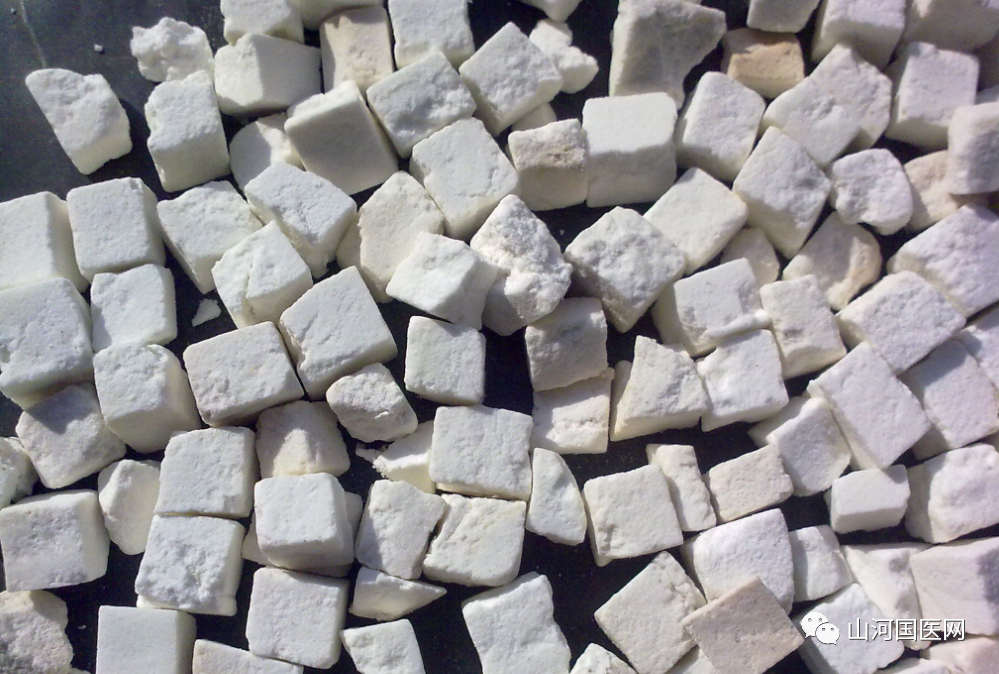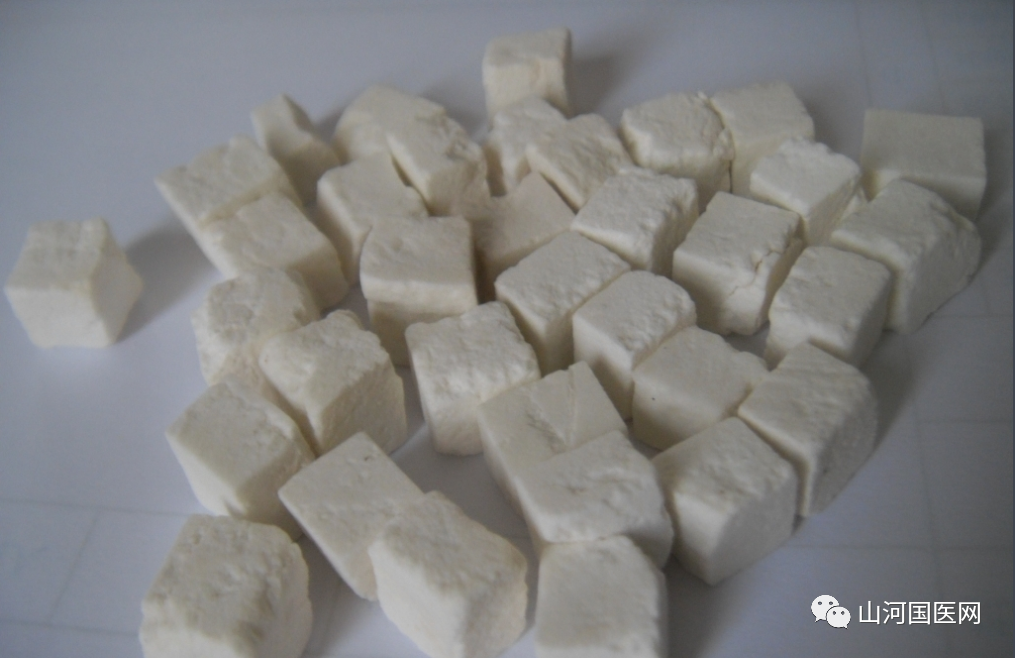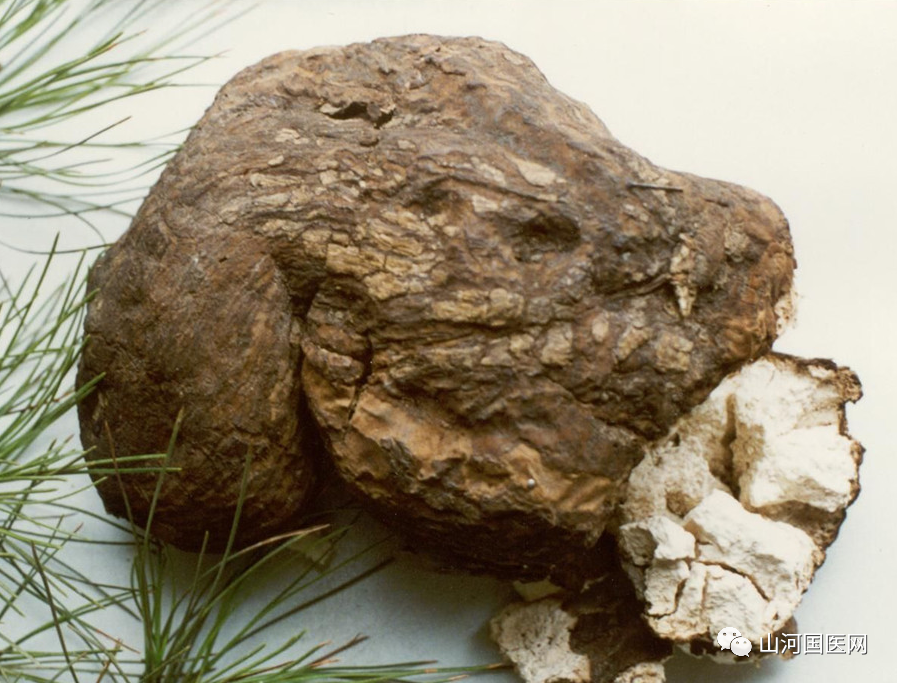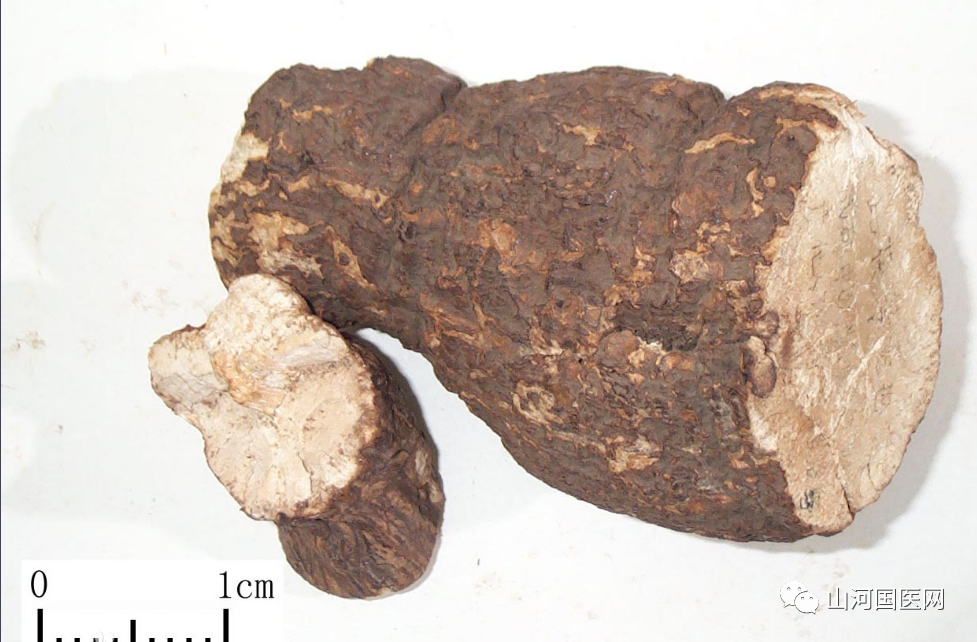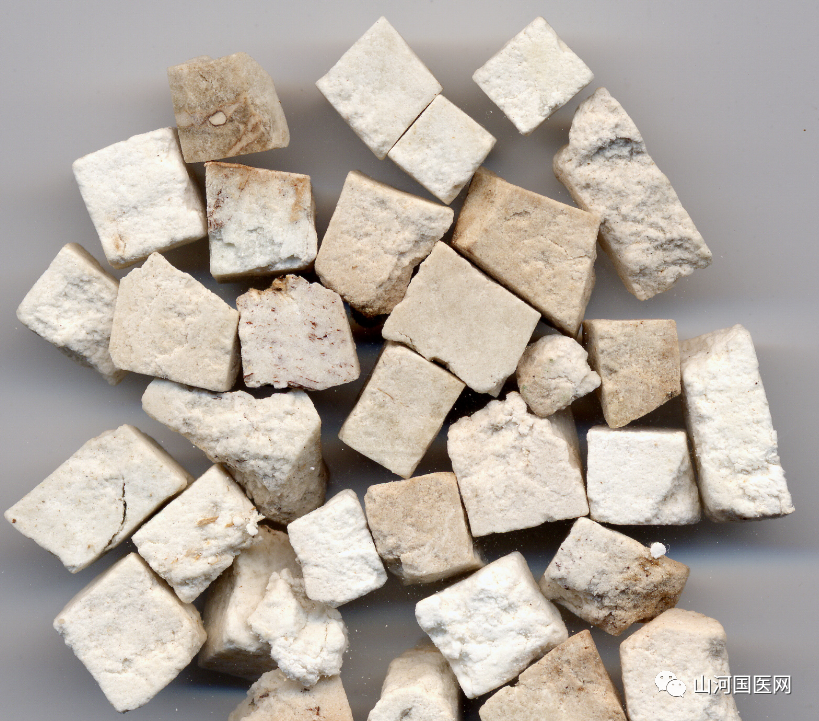| Poria Cocos Fú Línɡ | |
|---|---|
|
|
|
| Aliases | Poria, Poria Skin, Poria Block, Red Poria, White Poria, Fuling, Fuling, Fuling, Fuling, Fuling, Songyu, Jiangchen Futa, Yunling, Futu, Songshu, Songmushu, Songling, Busi Mian |
| Functions | Promotes urination and leaches out dampness, strengthens the spleen and calms the heart. Used for edema, reduced urination, phlegm and dizziness, spleen deficiency with poor appetite, loose stools, anxiety, palpitations, and insomnia. |
| English Name | Indian Buead, Tuckahoe |
| First Recorded In | Shennong Bencao Jing |
| Toxicity | |
| Meridians Entered | Heart, Lung, Spleen |
| Nature | Neutral |
| Taste | Sweet, Bland |
Poria Cocos, commonly known as Yunling, Songling, and Fuling, is a fungus that grows on the roots of pine trees, resembling sweet potatoes, with a black-brown outer skin and white or pink interior. It is the dried sclerotium of the fungus from the family Polyporaceae, primarily found on the roots of Masson pine or red pine. It is produced in Yunnan, Anhui, Hubei, Henan, and Sichuan. Ancient texts referred to Poria as a “divine medicine for all seasons” due to its broad efficacy, which can be combined with various herbs to treat ailments regardless of cold, heat, wind, or dampness. Poria has a sweet, bland taste and neutral nature, and is used in medicine for its ability to promote urination and leach out dampness, benefit the spleen and stomach, and calm the heart and spirit. Modern medical research indicates that Poria can enhance immune function, and Poria polysaccharides exhibit significant anti-tumor and liver-protective effects. However, it is contraindicated for those with deficiency-cold, slippery essence, or sinking qi.Basic Introduction【Herb Name】Poria Cocos【Aliases】Fuling (in Bencao), Fuling (in Shiji), Fuling (in Guangya), Fuling, Futu (in Tang Bencao), Songyu (in Jishi Zhu), Jiangchen Futa (in Youyang Zazhu), Yunling (in Dianhai Yuheng Zhi), Futu (in Gangmu), Songshu, Songmushu, Songling (in Guangxi Zhongyao Zhi).【Biological Classification】Belongs to the order Polyporales, family Polyporaceae, genus Poria.【Habitat Distribution】Grows on the roots of pine trees. Distributed in Hebei, Henan, Shandong, Anhui, Zhejiang, Fujian, Guangdong, Guangxi, Hunan, Hubei, Sichuan, Guizhou, Yunnan, and Shanxi.【Function Classification】Diuretic; damp-leaching diuretic.【Processing Varieties】 Poria Skin: The outer skin of the Poria sclerotium, functions to promote urination. Red Poria: The light red part after removing the outer skin, functions to leach out damp-heat. White Poria: The white part after cutting away the red Poria, also known as Poria, cut into small cubes, functions to leach out dampness and strengthen the spleen. Fushen: The center of white Poria containing fine pine roots, cut into square thin slices, functions to calm the heart and spirit.
Discussion on Medicinal Properties
Nature and Taste
【Nature and Taste】Sweet, bland, neutral.① Bencao: “Taste is sweet, neutral.”② Yixue Qiyuan: “The Secret of Treatment states it is warm, taste is bland.”【Meridians Entered】Enters the Heart, Lung, Spleen, and Kidney meridians.① Tangye Bencao: “Enters the Hand Taiyin, Foot Yangming, and Shaoyang meridians.”② Bencao Mengquan: “Enters the Bladder, Kidney, and Lung.”③ Leigong Paozhi Yao Xing Jie: “Enters the Lung, Spleen, and Small Intestine meridians.”④ Bencao Jing Shu: “Enters the Hand and Foot Shaoyin, Hand Taiyang, Foot Taiyin, and Yangming meridians.”
Functions and Indications
【Functions】Leaches out dampness and promotes urination; strengthens the spleen and stomach; calms the heart and spirit.【Indications】Difficult urination; edema; phlegm and cough; vomiting; spleen deficiency with poor appetite; diarrhea; palpitations; anxiety; insomnia; nocturnal emissions; and leukorrhea.
Various Perspectives
【Bencao Yulu】① Bencao: “Indicated for chest and flank counterflow qi, worry, fright, and palpitations, pain below the heart, cold-heat fullness, cough, dry mouth, and difficulty urinating.”② Bielu: “Stops thirst, promotes sleep, abdominal fullness, dripping, phlegm-water in the diaphragm, edema, and counterflow qi in the chest, regulates organ qi, expels kidney evil, nourishes yin, and benefits qi strength, protecting the spirit and maintaining balance.”③ Yaoxing Lun: “Opens the appetite, stops vomiting, calms the spirit. Treats lung atrophy and phlegm obstruction. Treats childhood fright convulsions, abdominal fullness, and women’s heat lin.”④ Rihua Zibencao: “Nourishes the five labors and seven injuries, calms the fetus, warms the lower back and knees, opens the mind, benefits intelligence, and stops forgetfulness.”⑤ Shanghan Ming Lili Lun: “Leaches out dampness and calms the spleen.”⑥ Yixue Qiyuan: “Removes dampness, benefits blood between the waist and navel, harmonizes the middle and benefits qi as the main function. Treats yellow or red urination that is not smooth. The Secret of Treatment states it stops diarrhea, removes deficiency-heat, opens the pores, and generates fluids.”⑦ Wang Haogu: “Drains the bladder, benefits the spleen and stomach. Treats kidney accumulation and running piglet syndrome.”⑧ Yao Zheng: “Indicated for palpitations and muscle twitching, also treats dizziness and irritability.”⑨ Tao Hongjing: “Poria, the white one nourishes, the red one drains.”⑩ Bencao Yanyi: “Poria and Fushen have many functions in promoting water, and benefiting the heart and spleen cannot be neglected.”⑪ Yongyao Xinfang: “Poria, bland can drain the orifices, sweet can assist yang, is the holy medicine for removing dampness. Its sweet and neutral nature nourishes yang, benefits the spleen, drains water, generates fluids, and guides qi.”⑫ Tangye Bencao: “Poria can drain the bladder, and can stop frequent urination, while it can also promote urination for those with difficulty. When soaked in wine and used with bright red cinnabar, it can seal the true essence.”⑬ Bencao Yanyi Buli: “Poria is often used to promote urination, this is the key medicine for treating acute new diseases, but if there is yin deficiency, it may not be suitable.”⑭ Gangmu: “Poria, Bencao also states it promotes urination, expels kidney evil, and according to Dongyuan and Wang Haizang, it can stop frequent urination and promote urination for those with difficulty. Zhu Danxi also states that those with yin deficiency should not use it, which seems contradictory, why? Poria is bland and leaches, its nature ascends, generates fluids, opens the orifices, nourishes the water source and descends, promotes urination, hence Zhang Jiegus states it belongs to yang, floating and ascending, which describes its nature; Dongyuan states it is yin among yang, descending and lowering, which describes its function. Suwen states that food enters the stomach, overflows with essence, ascends to the lungs, regulates the water pathways, and descends to the bladder. From this, it is known that bland leaching medicines all ascend before descending, not just descending. Frequent urination has different sources. Suwen states that when lung qi is abundant, urination is frequent and deficient, when deficient, it is less frequent, when heart deficient, it is less frequent, when the lower burner is deficient, it leads to incontinence, when heat moves to the bladder, it leads to incontinence, and when the bladder is not smooth, it leads to retention. The so-called abundant lung qi is real heat, and such a person must have strong qi and pulse, suitable for using Poria to leach out the heat, hence it is said that frequent urination can be stopped. However, those with lung deficiency, heart deficiency, heat in the bladder, and those with Jueyin disease are all deficient heat, and such a person must have upper heat and lower cold, with weak pulse, and should use yang ascending medicines to raise water and lower fire. When the bladder is not smooth, and the lower burner is deficient, it is fire attacking water, and the water source does not store, leading to symptoms of loss of yang, such a person must have cold limbs and slow pulse, and should use warm medicines to strongly tonify the lower burner, and the two conditions cannot be treated with bland leaching medicines like Poria, hence it is said that those with yin deficiency should not use it.”【Medical Family Directory】In using Poria, the purpose is to nourish rather than drain; the action of Poria is to drain rather than nourish. Where qi goes, water also follows; where qi stops, water also stops, hence it benefits water to move qi. Poria can calm the heart, benefit the spleen, and nourish the kidneys, as it moves tangible water and distributes intangible qi.Leaches water and moves qi, raises yin to follow yang, and distributes yang to transform yin, allowing clarity to rise and turbidity to descend, thus benefiting the heart, spleen, and kidneys.Poria is bland yet can leach, sweet yet can nourish, can drain and can nourish, making it a suitable medicine. It leaches dampness to treat edema and difficult urination, transforms phlegm to treat cough, and dampness entering the channels, strengthens the spleen and stomach, stops diarrhea, and calms the spirit to treat palpitations and insomnia. Its medicinal properties are neutral, causing no harm to the righteous qi, as it can both support the righteous and expel the evil, hence it is particularly suitable for conditions of spleen deficiency with excess dampness, righteous deficiency with evil excess.It is said in the medical book of the world: “Poria is the main medicine for treating phlegm. The root of phlegm is water, and Poria can leach water; the movement of phlegm is dampness, and Poria can act on dampness.” This indicates that its phlegm-transforming function is indeed related to its ability to leach water and dampness, which is not without reason. However, not all damp-leaching products can transform phlegm, thus the use of Poria has its uniqueness.
Dosage and Administration
Internal use: decoction, 10-15g; or in pills or powders. For calming the heart and spirit, mix with cinnabar.
Medicinal Compatibility
If biased towards cold dampness, it can be combined with cinnamon twig, white atractylodes, etc.; if biased towards damp-heat, it can be combined with polyporus, and alisma; if it belongs to spleen qi deficiency, it can be combined with codonopsis, astragalus, and white atractylodes; if it is deficient cold, it can also be combined with aconite and white atractylodes. For diarrhea and leukorrhea caused by spleen deficiency and abnormal transformation, using Poria has the effect of addressing both the root and the branch, often combined with codonopsis, white atractylodes, and Chinese yam. It can be used as an auxiliary medicine to tonify the lung and spleen, treating qi deficiency. For spleen deficiency unable to transform water and dampness, leading to accumulation and transformation into phlegm, it can be used with pinellia and dried tangerine peel, and can also be combined with cinnamon twig and white atractylodes. For phlegm dampness entering the channels, shoulder and back pain, it can be combined with pinellia and bitter orange. For anxiety, palpitations, and insomnia, it is often combined with ginseng, polygala, and sour jujube seed.
Contraindications
Use with caution in cases of yin deficiency without damp-heat, deficiency-cold, slippery essence, or sinking qi.① Bencao Jing Jizhu: “Horse lily is used as a guide. Avoid white astringents. Be cautious of male yellow, earth elm, realgar, gentian, and tortoise shell.”② Yaoxing Lun: “Avoid rice vinegar.”③ Zhang Yuansu: “If there is frequent urination or several times, using it will harm the eyes. If there is excessive sweating, using it will harm the original qi.”④ Bencao Jing Shu: “Patients with kidney deficiency, frequent urination, or inability to control or slippery essence should not take it.”⑤ Depei Bencao: “Qi deficiency, sinking, and dry mouth are all contraindicated.”
Main Applications
Clinical Applications
⑴ Used for difficult urination, edema, etc. Poria functions to promote urination and leach out dampness, and its medicinal properties are neutral, benefiting water without harming righteous qi, making it a key medicine for promoting urination and leaching out dampness. For symptoms of difficult urination and stagnation of water and dampness, regardless of whether it is biased towards cold dampness, damp-heat, or spleen deficiency with damp accumulation, it can be used in combination. If biased towards cold dampness, it can be combined with cinnamon twig, white atractylodes, etc.; if biased towards damp-heat, it can be combined with polyporus, and alisma; if it belongs to spleen qi deficiency, it can be combined with codonopsis, astragalus, and white atractylodes; if it is deficient cold, it can also be combined with aconite and white atractylodes.⑵ Used for spleen deficiency diarrhea and leukorrhea. Poria can strengthen the spleen and leach out dampness, and for diarrhea and leukorrhea caused by spleen deficiency and abnormal transformation, using Poria has the effect of addressing both the root and the branch, often combined with codonopsis, white atractylodes, and Chinese yam. It can be used as an auxiliary medicine to tonify the lung and spleen, treating qi deficiency.⑶ Used for phlegm damp cough, phlegm damp entering the channels, shoulder and back pain. Poria can leach out dampness and strengthen the spleen, and for phlegm dampness unable to transform water and dampness, leading to accumulation and transformation into phlegm, it has therapeutic effects. It can be used with pinellia and dried tangerine peel, and can also be combined with cinnamon twig and white atractylodes. For phlegm dampness entering the channels, shoulder and back pain, it can be combined with pinellia and bitter orange.⑷ Used for palpitations and insomnia. Poria can nourish the heart and calm the spirit, hence it can be used for anxiety, palpitations, and insomnia, often combined with ginseng, polygala, and sour jujube seed.⑸ Anti-cancer. Clinically used to treat esophageal cancer, gastric cancer, liver cancer, nasopharyngeal cancer, tongue cancer, breast cancer, bladder cancer, lung cancer, and ulcerative melanoma, particularly in cases of spleen deficiency with excess dampness, phlegm stagnation, and damp-heat obstruction.
Classic Formulas
⑴ For treating Taiyang disease, after sweating, with excessive sweating, dryness in the stomach, restlessness, and difficulty sleeping, pulse floating, and difficult urination, slight heat and thirst: 18g of polyporus (peeled), 1.6g of alisma, 18g of white atractylodes, 18g of Poria, and 15g of cinnamon twig (peeled). Combine the five ingredients, crush into a powder. Mix with white drink and take a dose the size of a thumb three times a day. (Shanghan Lun Wuling San)⑵ For treating frequent urination, slippery and frequent: White Poria (peeled), 1.5g, dried Chinese yam (peeled, soaked in alum water, dried over low heat). Combine the two ingredients in equal parts, grind into a fine powder. Take with thin rice drink. (Rumen Shiqin)⑶ For treating edema: 2g of pure water, 3g of Poria, and 1.5g of yuli ren (crushed). Add ginger juice and decoct. (Bu Zhi Yi Biao Poria Decoction)⑷ For treating skin edema, swelling of the limbs, and water qi in the skin, with limbs feeling heavy: 3g of prepared aconite, 3g of astragalus, 3g of cinnamon twig, 6g of Poria, and 2g of licorice. Combine the five ingredients, boil in 6 liters of water until 2 liters remain, divide into three warm doses. (Jinkui Yaolue Poria Decoction)⑸ For treating phlegm and water in the heart, fullness in the chest and flanks, dizziness: 4g of Poria, 3g of cinnamon twig, 3g of white atractylodes, and 2g of licorice. Combine the four ingredients, boil in 6 liters of water until 3 liters remain, divide into three warm doses, urination will be smooth. (Jinkui Yaolue Poria, Cinnamon, Atractylodes, Licorice Decoction)⑹ For treating sudden vomiting, fullness in the heart, and water in the diaphragm, dizziness: 1g of pinellia, 0.5kg of ginger, and 3g of Poria (or 4g). Combine the three ingredients, boil in 7 liters of water until 1 liter remains, divide into three warm doses. (Jinkui Yaolue Small Pinellia Decoction with Poria)⑺ For treating persistent diarrhea: 2g of white Poria, and 0.5g of south wood fragrance (wrapped in paper and roasted). Combine the two ingredients into a fine powder, decoct with perilla and papaya soup, take two doses. (Bai Xuan Fang)⑻ For treating damp diarrhea: 1g of white atractylodes, and 7.5g of Poria (peeled). Cut finely, decoct with 1 liter of water, take before meals. (Yuan Bing Shi Poria Decoction)⑼ For treating stomach reflux, vomiting and thirst, desiring to drink water: 0.5kg of Poria, 4g of alisma, 2g of licorice, 2g of cinnamon twig, 3g of white atractylodes, and 4g of ginger. Combine the six ingredients, boil in 10 liters of water until 3 liters remain, add alisma and boil again until 2.5 liters remain, take 8 doses warm, three times a day. (Jinkui Yaolue Poria and Alisma Decoction)⑽ For treating male yang deficiency, fatigue, essence not firm, frequent nocturnal emissions, cloudy urination, frequent dreams, and for women with prolonged cold blood, leukorrhea, white discharge, and constant dampness in the lower body, urination like rice wash water, or infertility: 4g of yellow wax, and 4g of white Poria (peeled, in chunks, with 1g of polyporus, boiled in porcelain for over 20 minutes, then dried, do not use polyporus). Grind Poria into powder, melt yellow wax into balls the size of a marble. Chew slowly and swallow with warm water, until urination is clear. (Jufang Weixi Wan)⑾ For treating heart deficiency and dream emissions, or leukorrhea: 2g of white Poria powder. Take with rice soup, twice a day. (Renzhai Zhizhi Fang)⑿ For treating heart sweat, with no sweat elsewhere, only sweating from the heart, excessive thinking leads to more sweat, the disease is in the heart, suitable for nourishing heart blood: take Poria powder with mugwort soup. (Zhengzhi Yaojue)⒀ For treating lower deficiency thirst, upper excess and lower deficiency, heart fire burning, kidney water dried up, unable to interact leading to thirst: 1kg of white Poria, and 1kg of coptis. Grind into powder, mix with tianhuafen to make pills the size of wutong seeds. Take 50 pills with warm soup. (Desheng Tang Experience Formula)⒁ For treating head wind and dizziness, warming the lower back and knees, treating the five labors and seven injuries: Poria powder mixed with rice wine. (Gangmu Poria Wine)⒂ For treating skin lesions: Mix white honey with Poria and apply, leave for seven days. (Buque Zhouhou Fang)
Famous Formulas and Proven Recipes
Poria contains Poria polysaccharides, B-Poria polysaccharides, Poria acid, lecithin, and sterols. It has detoxifying and anti-cancer effects, promotes urination and transforms phlegm, strengthens the spleen and calms the spirit. Modern clinical studies show that Poria polysaccharides and Poria polysaccharide complexes (U-P), methylated Poria polysaccharides, and Poria oligosaccharides have inhibitory and lethal activity against various tumors in experimental animals. The inhibitory effect on S180, EAC, and ascitic tumor strains is similar to that of oral 5-FU, and the inhibitory effect is dose-dependent, but with lower toxicity. ⑴ Detoxifying and Anti-Cancer ① Tumor accumulation, lung cancer. Poria, Ophiopogon, and Chuanbei each 15g, purple river car, cooked earth, raw earth, alisma, pig gall, purple shell, and shouwu, longgu each 12g, angelica, white peony, nu zhen zi, white atractylodes, clove, shenqu, malt, hawthorn, chicken inner gold, and ejiao (melted) each 9g, sand ginger, and ginseng each 6g, cinnabar, amber, and licorice each 3g, oyster and yuyuliang each 30g, decoct and take once a day. After a week of continuous use, switch to the following: half-branch lotus and humei each 30g, decoct and take once a day. After a week of continuous use, switch back to the previous formula. Continue alternating until basic symptoms such as phlegm, cough, and chest pain are alleviated, and X-ray re-examination shows disappearance of shadows. ② Gastric cancer. Poria, longkui, and half-branch lotus each 15g, red ginseng, white atractylodes, and astragalus each 9g, and hezi meat 6g, dried ginger, clove, and roasted licorice each 3g, decoct and take once a day. This can gradually improve symptoms such as facial swelling, foot swelling, abdominal distension, and loose stools, and improve appetite. Esophageal cancer: 45g of Poria, zheshi, qingbanxia, and shizhu root each 30g, su geng and olive each 18g, bitter orange 15g, tangerine peel and ginger each 9g, borax 3g, decoct twice, take in the morning and evening, once a day, continue taking, can alleviate symptoms, facilitate eating, and X-ray re-examination shows significant reduction of cancer lesions. ③ Liver cancer: 45g of Poria, longkui each 45g, white flower, and half-branch lotus each 15g, white peony, and danpi each 9g, xuan shen 6g, decoct twice and take in portions. This can gradually alleviate subjective symptoms, and the liver shrinks to normal range. ④ Lymphoma: Poria, danshen, and raw oyster each 30g, turtle shell 15g, yujin, bitter orange, white atractylodes, chaihu, red flower, wulingzhi, chicken inner gold, and white peony each 9g, musk and sand ginger each 6g, licorice 4.5g, decoct and take. This can alleviate symptoms, and after three months, imaging shows lymph nodes shrinking. ⑤ Cervical cancer: Poria, half-branch lotus, and shuyang spring each 30g, Chinese yam, raw earth each 15g, zhi mu, huangbai, and alisma each 9g, white peony 6g, and 10 jujubes, decoct and take. This can reduce leukorrhea, frequency of urination, and lumbar pain, and the local lesions disappear. ⑥ Uterine fibroids: Poria, cinnamon twig, angelica, and white peony each 180g, peach kernel, red peony, seaweed, oyster, and turtle shell each 120g, red flower 75g, sanling, e zhu, frankincense, and myrrh each 60g, grind into fine powder, mix with honey to form Poria and cinnamon twig pills, each pill weighs 9g, take 1 pill three times a day with warm water, continue for 1 year, can normalize menstruation and eliminate fibroids. ⑦ Leukemia: Poria, happy tree root bark each 15g, white flower, white flower snake tongue grass, verbena, and sunflower seeds each 9g, decoct and take. This can lead to complete or partial alleviation of symptoms, prolonging survival, suitable for all types of acute leukemia. ⑧ Ulcerative melanoma: Poria and realgar each in equal parts, grind into powder, apply with sesame oil, and take orally with honeysuckle and lianqiao each 50g decoction. (Anti-Cancer Plants and Their Proven Recipes) ⑵ Promoting Urination and Transforming Phlegm ① Water damp phlegm: Treating water damp accumulation: 30g of Poria, 15g of white atractylodes, 12g of pig gall, big abdomen skin, and papaya each 12g, areca, su geng, alisma, mulberry bark, and dried tangerine peel each 9g, ginseng and roasted licorice each 3g, decoct and take. ⑶ Strengthening the Spleen and Calming the Spirit ① Spleen deficiency unable to transform: 60g of Poria, codonopsis, and white atractylodes, 30g of shenqu, malt, hawthorn, Chinese yam, sand ginger, dried tangerine peel, and nutmeg each 30g, 22g of wood fragrance, huanglian, and licorice, grind into fine powder, and take 9g twice a day with warm water. ② Heart spirit not nourished: 9g of Poria, 15g of sour jujube seed, 6g of zhi mu, 4.5g of chuanxiong, and 3g of licorice, decoct and take, suitable for insomnia, palpitations, and dizziness.
Dietary Therapy and Health Care
Poria contains Poria polysaccharides, glucose, protein, amino acids, organic acids, fats, lecithin, adenine, choline, ergosterol, various enzymes, and potassium salts. It can enhance immune function, Poria polysaccharides have significant anti-tumor effects; it has diuretic effects, can increase the excretion of potassium, sodium, chloride, and other electrolytes in urine; has sedative and liver-protective effects, inhibits the occurrence of ulcers, lowers blood sugar, and has anti-radiation effects. Poria is also used in Poria cakes, Poria pastries, and Poria wine. In some countries, Poria is used as a common medicinal and tonic material for the navy. In warmer regions and places, Poria can be an important dietary therapy variety, regularly consuming it can strengthen the spleen, eliminate dampness, aid digestion, and enhance physical fitness. 1. Poria Cake: 200g of Poria, 10g of ginseng, 800g of flour. Grind the two herbs into fine powder, add a little salt, mix with flour and water to form a dough, make several cakes weighing about 100g each, and bake until cooked. Take 1 each time. This recipe is derived from Revised Ruizhutang Experience Formula (originally called “Dan”, actually a snack). This formula uses Poria and ginseng to tonify qi and benefit the spleen, with ginseng delaying aging. It is used for tonifying deficiency and anti-aging. 2. Poria and Chestnut Porridge: 15g of Poria, 25g of chestnuts, 10 jujubes, and 100g of glutinous rice. Boil the chestnuts, jujubes, and glutinous rice in water; grind Poria into powder, and when the rice is half-cooked, gradually add it, stirring until the chestnuts are fully cooked. Sugar can be added for flavor. This formula uses Poria to tonify the spleen and leach out dampness, chestnuts to tonify the spleen and stop diarrhea, and jujubes to benefit the spleen and stomach. It is used for spleen and stomach weakness, reduced appetite, and loose stools. 3. Poria Chicken Wontons: 50g of Poria, appropriate amount of chicken, and 200g of flour. Grind Poria into fine powder, mix with flour and water to form a dough, chop the chicken finely, add ginger, pepper, and salt to make the filling, wrap into wontons, and cook. This recipe is derived from Fengqin Yanglao Shu. This formula uses Poria to tonify the spleen and leach out dampness, chicken to tonify the spleen and benefit qi, ginger and pepper to open the appetite and aid digestion. It is used for spleen and stomach weakness, vomiting, reduced appetite, and indigestion. 4. Poria and Mai Dong Porridge: 15g of Poria and Mai Dong, and 100g of millet. Cook millet in water; decoct the two herbs to obtain a concentrated juice, and when the rice is half-cooked, add it together and cook until done. This recipe is derived from Shenghui Fang. This formula uses Poria to calm the heart and spirit, Mai Dong to nourish yin and clear the heart, and millet to eliminate heat. It is used for heart yin deficiency, heart heat, anxiety, insomnia, and dry mouth. 5. Poria Wine: 60g of Poria, 20 jujubes, 12g of angelica, 12g of goji berries, and 1500ml of white liquor. Cut the herbs into pieces, place in a jar, pour in the liquor, seal and soak for 15 days, shaking every three days, take 1-2 times a day, 10-15ml each time. Suitable for those with qi and blood deficiency, yin and yang deficiency leading to symptoms such as back pain, leg weakness, fatigue, nocturnal emissions, impotence, premature graying, palpitations, insomnia, and reduced appetite. 6. Poria Paste: 500g of white Poria, 1000g of white honey. First, grind white Poria into fine powder, wash away the floating parts with water, take the sediment, filter out the water, and repeat the process three times. Then grind into fine powder again, mix with white honey, heat and boil until it forms beads when dripped in water, then bottle for storage. Take 15g twice a day with warm water. Regular consumption of this product is beneficial for elderly edema, obesity, and cancer prevention.
Source of Medicinal Material
【Source】The dried sclerotium of the fungus Poria cocos (Schw.) Wolf from the family Polyporaceae.The outer skin of this sclerotium (Poria Skin), the light red part near the outer skin (Red Poria), and the white part containing pine roots (Fushen) are used medicinally.【Verification】Originates from Shennong Bencao Jing.1. Bielu: Poria and Fushen grow in the valleys of Mount Tai. Harvest in February and August, and dry in the shade.2. Tao Hongjing: Poria is now produced in Yuzhou. Naturally formed ones are as large as three or four liters, with a black outer skin, fine wrinkles, and a hard white interior, resembling birds or beasts. Those with pine roots are called Fushen, which are of secondary quality. They are used for treatment, and should not be rejected.3. Bencao Tujing: Poria, the current method of harvesting by eastern people is to find it in ancient pine forests, where it has been cut down for a long time, and its branches and leaves do not grow back. This is called Poria digging. When found, one should use an iron-tipped awl to pierce the ground. If Poria is present, the awl cannot be pulled out, and then it can be dug out. Often, one piece weighs 20-30 jin, and there is no difference, only weight is the standard. The fully transformed ones are Poria, while those with wood cores are Fushen. In the past, dense forests had many Porias, and large ones were often found, but recently, sparse forests have fewer Porias, and large ones are only about 3-4 jin to 7-8 jin, and none have reached 20-30 jin. Since the trade of Poria from Anqing, the supply of Yunling has decreased significantly, making it very precious. The books of Li Shizhen and Wang Yan’an do not mention Yunling. The weight of Yunling should be from the Kangxi period.4. Fake Medicine Classification: Poria should be taken whole and sliced, with a slight presence of connective tissue being genuine, and if sliced, the pieces should curl up, with pure white being the best.5. Medical Records of the West: Poria, if used in decoctions, should be cut into thin slices, or ground into powder, to ensure thorough cooking.【Harvesting and Storage】Poria matures 8-10 months after planting, with maturity marked by the appearance of cracks on the surface, revealing a yellow-brown color without white cracks, indicating it is ready for harvest. It should be harvested on sunny days, cleaned of dirt and sand, piled indoors covered with straw to sweat until the moisture dries, and the skin wrinkles, then the outer skin is removed and dried.Wild Poria is generally harvested from July to March of the following year in Masson pine forests. The ground where Poria grows typically has the following characteristics: 1. The ground around the stumps of pine trees has cracks, and when struck, it sounds hollow; 2. There are white mycelium (appearing as a powdery white membrane or grayish-white) on the ground near the pine trees; 3. After the stumps rot, there are black-red horizontal cracks; 4. After light rain, the ground around the stumps dries quickly, or there are areas where grass does not grow.Processing: After Poria is unearthed, wash off the dirt, pile it in a corner of the house where there is no ventilation, or store it in a jar, laying a layer of pine needles or straw at the bottom, and then layer Poria with straw, covering with thick burlap to allow it to “sweat” and release moisture. Then take it out, wipe off the water droplets, spread it in a cool place, and wait for the surface to dry before sweating again. Repeat this process 3-4 times until the surface shrinks and the skin color turns brown, then place it in a cool, dry place to air dry completely, which is known as “Poria Ge.”Cutting: After sweating, cut while moist, or take dried Poria and soak it in water before cutting. The white part inside the Poria sclerotium is cut into thin slices or small cubes, known as white Poria; the black outer skin is cut off, known as Poria Skin; the red part beneath the skin is cut into blocks, known as Red Poria; and the white part containing pine roots is cut into square thin slices, known as Fushen. All processed products must be air-dried, not roasted or sun-dried, and should be placed in a cool place, avoiding excessive dryness or ventilation to prevent loss of stickiness or cracking.1. Identification of Medicinal Material Complete Poria is round, oval, flat, or irregular lumps, varying in size. The outer skin is thin, brown or black-brown, rough, with wrinkles and constrictions, sometimes partially peeling off. It is solid, with a granular fracture surface, light red near the edge, with small honeycomb-like holes, and white or slightly red inside. Some contain pine roots, commonly referred to as “Fushen blocks.” It has a faint odor, bland taste, and is sticky when chewed. The best quality is firm, with brown outer skin, fine skin texture, no cracks, and a delicate white fracture surface that is sticky to the teeth.Poria Skin: The outer skin of Poria, varying in shape and size. The outer surface is brown to black-brown, and the inner surface is white or light brown. It is softer and slightly elastic.Poria Block: The Poria after peeling, cut into block shapes, varying in size. White, light red, or light brown.Red Poria: The brown-red or light red part cut into blocks or slices.White Poria: The white part after cutting away the red Poria.2. Microscopic Identification Powder characteristics: grayish-white. ① Using Schisandra liquid for slide preparation, irregular colorless granules, blunt round ends, and fine hyphae can be seen; when encountering water, it forms a gelatinous mass with chloral hydrate solution, and heating dissolves the granules. ② Using 5% potassium hydroxide solution for slide preparation, long hyphae can be seen, slightly curved, branched, colorless (inner hyphae), or brown (outer hyphae), varying in length, with a diameter of 3-8 (up to 16) μm, with septa occasionally visible.3. Chemical Identification (1) Take 1g of the powdered product, add 10ml of acetone, and heat under reflux for 10 minutes, filter, evaporate the filtrate, dissolve the residue in 1ml of acetic acid, and add 1 drop of sulfuric acid, showing a light red color, then turning light brown. (2) Take a small amount of Poria slices or powder, add 1 drop of potassium iodide solution, showing a deep red color.
Disclaimer:The content of this site is added and organized by users, for learning and reference only. The information on the site may not be accurate, comprehensive, or up-to-date, and the content should not be the final basis for diagnosing or treating diseases.Shanhe Traditional Chinese Medicine Networkreminds users that if there are any physical discomforts, please seek medical attention promptly. Thank you for your support and love, we will do better~!!!


